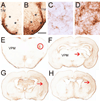Neonatal sensory nerve injury-induced synaptic plasticity in the trigeminal principal sensory nucleus
- PMID: 25956829
- PMCID: PMC4636484
- DOI: 10.1016/j.expneurol.2015.04.022
Neonatal sensory nerve injury-induced synaptic plasticity in the trigeminal principal sensory nucleus
Abstract
Sensory deprivation studies in neonatal mammals, such as monocular eye closure, whisker trimming, and chemical blockade of the olfactory epithelium have revealed the importance of sensory inputs in brain wiring during distinct critical periods. But very few studies have paid attention to the effects of neonatal peripheral sensory nerve damage on synaptic wiring of the central nervous system (CNS) circuits. Peripheral somatosensory nerves differ from other special sensory afferents in that they are more prone to crush or severance because of their locations in the body. Unlike the visual and auditory afferents, these nerves show regenerative capabilities after damage. Uniquely, damage to a somatosensory peripheral nerve does not only block activity incoming from the sensory receptors but also mediates injury-induced neuro- and glial chemical signals to the brain through the uninjured central axons of the primary sensory neurons. These chemical signals can have both far more and longer lasting effects than sensory blockade alone. Here we review studies which focus on the consequences of neonatal peripheral sensory nerve damage in the principal sensory nucleus of the brainstem trigeminal complex.
Keywords: Astrocytes; Infraorbital nerve; Reactive synaptogenesis; Silent synapses; Whisker–barrel system.
Published by Elsevier Inc.
Conflict of interest statement
The authors declare no conflict of interest.
Figures




References
-
- Adams JC. Thrombospondins: multifunctional regulators of cell interactions. Annu. Rev. Cell Dev. Biol. 2001;17:25–51. - PubMed
-
- Alcalá-Galiano A, Arribas-García IJ, Martín-Pérez MA, Romance A, Montalvo-Moreno JJ, Juncos JM. Pediatric facial fractures: children are not just small adults. Radiographics. 2008;28:441–461. - PubMed
-
- Aldskogius H, Arvidsso J. Nerve cell degeneration and death in the trigeminal ganglion of the adult rat following peripheral nerve transection. J. Neurocytol. 1978;7:229–250. - PubMed
-
- Aldskogius H, Arvidsson J, Grant G. The reaction of primary sensory neurons to peripheral nerve injury with particular emphasis on transganglionic changes. Brain Res. 1985;357:27–46. - PubMed
-
- Allen NJ. Role of glia in developmental synapse formation. Curr. Opin. Neurobiol. 2013;23:1027–1033. - PubMed
Publication types
MeSH terms
Grants and funding
LinkOut - more resources
Full Text Sources
Other Literature Sources
Medical

